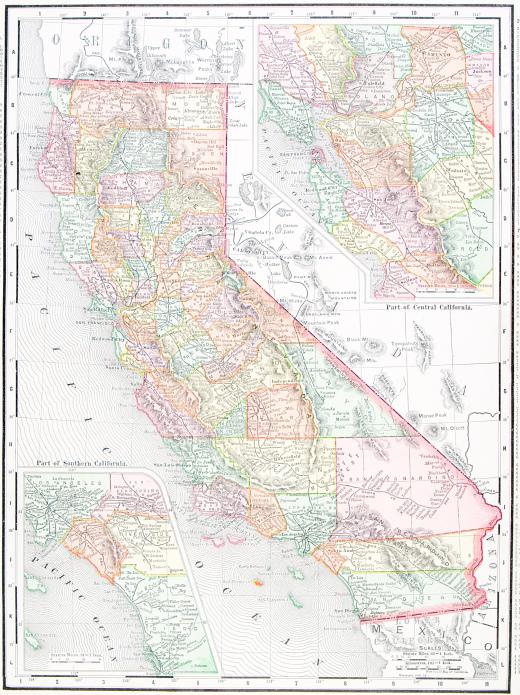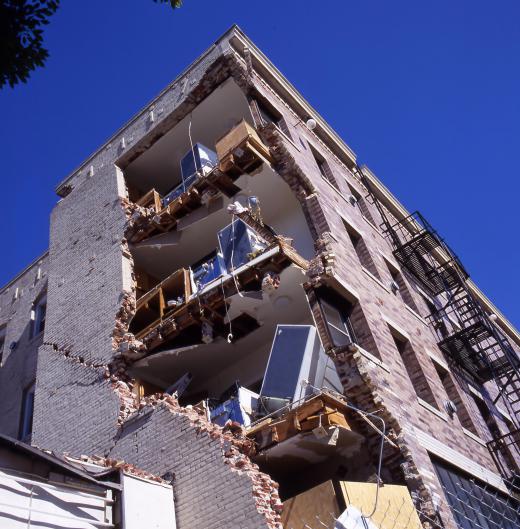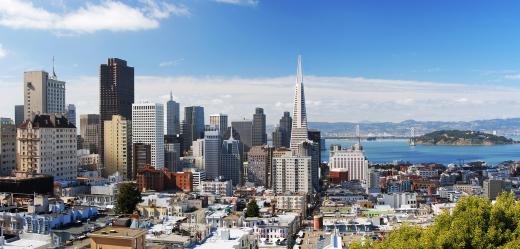What is the San Andreas Fault?
 Mary McMahon
Mary McMahon
The San Andreas Fault is a major geologic fault that runs along the coast of Northern California, veering inland as it approaches Southern California. Because the fault runs along heavily populated regions of the state, it is often a topic of discussion, as a major earthquake there could be a very serious problem for California. The San Francisco Earthquake of 1906, for example, was caused by movement along the fault, and geologists monitor it carefully for signs that another big earthquake may be on the way.
Like other faults, the San Andreas Fault is a fracture in the Earth's crust which is marked by increased geological activity. It is a transform fault, which means that it is located along the boundary between two tectonic plates. The Pacific Plate meets the North American Plate there, with a smaller plate called the Juan De Fuca Plate located at the Northern end of the fault. It is also classified as a strike-slip fault, because the two plates are actually sliding past each other, with the Pacific plate slowly moving northwards.

Andrew Lawson, a geology professor at the University of California, Berkeley, discovered the San Andreas Fault in 1895. He named it for a lake, the Laguna de San Andreas, which was formed by movements along the fault line. He was the first to realize that the geologic fault actually extended all the way into Southern California, and he also identified a number of associated faults, such as the Hayward Fault.

Movements of the fault have contributed immensely to the landscape of California. It is even clearly visible in some places, as people who have flown over it have noticed. Along the fault line, large piles of rock and dirt have been thrust up to create clear, straight lines that can be used to trace the progress of the fault as it works its way down the coast of California. As it has moved, it has created mountains, valleys, and lakes, many of which are enjoyed as recreation areas by Californians who may not be aware that they are literally treading on dangerous ground.

The San Andreas Fault is actually constantly in motion, although most of its small earthquakes are only detectable with advanced geological equipment. Many more noticeable earthquakes appear throughout California every week, with occasional big jolts. Catastrophic earthquakes along thefault cannot be predicted; one might happen in the next 10 minutes or in the next 200 years, and no one is really sure about when the next “big one” might occur, although geologists certainly try to analyze activity along the fault for warning signs.
AS FEATURED ON:
AS FEATURED ON:















Discussion Comments
what is it going to do to california if we break down the fault and fill it up?
I would sincerely hope for all you California residents' sakes that, should "the big one" strike soon, most of the buildings will stay in one piece, as they're built to do.
Having visited California in November last year, I fell in love with it, but I am very much intrigued by the San Andreas fault and its threats. It is a fascinating thing. Stay lucky everyone, I hope to visit again in the not too distant future.
DS, Birstall, West Yorkshire, England.
Here is a thought I have had for some years now. Keeping in mind that the experts say the earth's oil reserves are running low. If you look at the mere fact of the usage of fossil fuels has been basically over the past century. Is that a direct correlation of the absence of volume in the amount of the oil depleted and the interaction of the tectonic plates wanting to adjust for the displaced oil.
I have no idea about the total volume we are talking about but (i would think)it has to be some factor doesn't it??
The San Andreas Fault is a "transform" fault. That means the two sides slide past one another. Both plates mentioned in the article are pressing against one another. Saying that a big earthquake will cause "...all of California west of the fault (to slip) into the sea,..." is like saying that if you push a phone book against the wall it'll suddenly fly out of a window. But that nightmare picture makes for great headlines and sells lots of newspapers.
California is my (our) distant early warning line. That lets us predict what abnormal behavior will appear later in the rest of the country.
If the fault really slips and all of California west of the fault slips into the sea, we will lose any early warning.
Did the restless keep moving west until the sea stopped them?
Now I understand that people are leaving the state and going to Oregon or Washington (I understand that they are not welcome there though), but now Arizona and Nevada are getting more ex-Californians.
What with Florida's Hurricanes, New Mexico's droughts and California's earthquakes it's getting so a true hedonist can't find a friendly climate to call home!
Post your comments